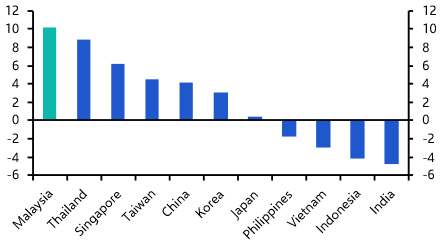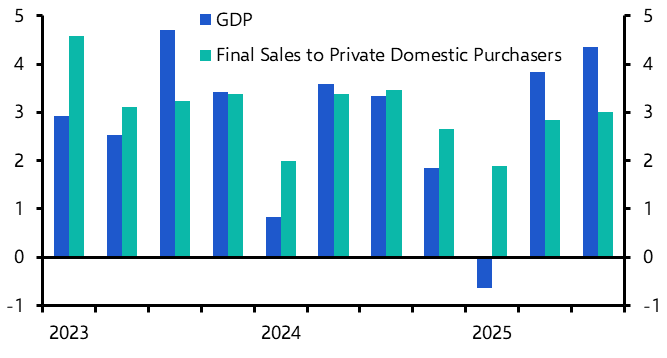The spread of coronavirus cases through Asia and Europe convulsed financial markets last week and led the forecasting community to speculate about the potential impact of a global pandemic on world GDP growth. In truth, any such estimate is almost worthless. That’s because the economic impact of any such event will be determined by a multitude of different factors that render any point forecast meaningless. Instead, it makes more sense to think about the channels through which the spread of the virus will impact economic growth and, based on these, identify the countries and sectors which look most vulnerable.
As we’ve argued before, a key point to keep in mind is that it’s the measures to contain the virus – rather than the virus itself – that create much of the economic damage. China’s government imposed relatively draconian measures in an effort to limit the spread of the virus. At one point earlier this month, provinces accounting for over two-thirds of China’s economy were effectively in lockdown. We now expect China’s economy to contract by 2% y/y (6.25% q/q) in the first quarter of this year on our China Activity Proxy measure. If other countries were to follow Beijing’s lead then the damage to their economies would be similar.
But recent experience of only limited shutdowns in Japan, Italy and Korea suggests that the response – and the resulting economic disruption – in other countries is unlikely to be as severe as in China. Moreover, if cases start to spring up in many countries and cannot be traced, then it’s possible that the authorities may simply conclude that the horse has bolted and there is little point in imposing widespread restrictions.
The response of the governments in newly affected countries is therefore crucial but at this stage largely unknown. In addition, four other factors will determine the extent to which individual economies are affected by the spread of the virus.
The first is the impact of virus-related slowdowns in other countries. This can come through either weaker export demand or through disruption to imported components within supply chains. So far there is limited evidence of widespread disruption outside of Asia, although there are various reports that specific manufacturers (of cars and electronics in particular) are starting to experience problems. But around 40% of world trade is accounted for by just five countries: China, South Korea, Japan, Germany and the US. The first three of these countries have already been seriously affected by the virus. Evidence of its spread to Germany and the US could prove to be the straw that breaks the camel’s back.
The second channel through which the spread of the virus will impact on individual economies is via the response of households and, in particular, the extent to which people self-isolate by avoiding public spaces and travel. These effects are already clearly evident in China. In the event of a global pandemic, the worst affected economies would include those most dependent on tourism, including Mexico, Egypt, Croatia and Thailand.
The third factor to consider is the extent to which virus concerns cause financial market dislocation and disrupt global capital flows. Such concerns have become front and centre over the past few days. But despite the sharp fall in equity markets, our own measure suggests that there has not (yet) been a significant tightening of global financial conditions. If conditions do tighten, emerging economies with large external debts are likely to be among the most vulnerable (keep an eye on Turkey and South Africa). Likewise, highly leveraged companies and sectors may feel the squeeze (keep an eye on the energy sector).
The fourth and final factor to think about is how policymakers respond. The economic shock caused by the virus is unusual insofar as it affects both the supply- and the demand-side of the economy. Widespread shutdowns and travel restrictions constrain supply. But fewer trips to cinemas and restaurants, and reduced consumer spending more generally, weakens demand. There’s not much that monetary or fiscal policy stimulus can do to address the former. And it’s doubtful that it can do much to support demand in the very short term either, given the time it takes for looser policy to filter through to the real economy.
Even so, policymakers are not entirely impotent. Fiscal policy is probably more effective at countering any hit to demand since it can be targeted on the areas of the economy that are hit hardest. For example, China’s government provided subsidies and loans to the worst hit firms and to those involved in prevention and treatment of the coronavirus. Italy’s government has announced a similar package of support. Given the collapse in bond yields over the past week, it’s difficult to believe that markets would baulk at the prospect of fiscal stimulus in most economies.
Meanwhile, monetary policy has a role to play in countering the fallout in financial markets. If the stock market slide intensifies and/or credit spreads widen, then the risks of a negative feedback loop to aggregate demand increase. Central banks can break this loop by loosening policy. The early signs are that statements issued by the Fed and the BoJ over the past two days have helped to calm market nerves. This has bought central banks some time. The next test will now be whether warm words in statements translate into policy action in practice.
We analysed all of this in more detail in a note published on our Global Economics service last week (you can read it here). The short point, however, is that it’s best to think about a range of possible scenarios in which this might play out. At the benign end of the spectrum, in which most of the disruption is contained to China, we think the global economy may grow by about 2.5% this year. That would be the weakest pace of expansion since 2009. At the other end of the spectrum, it’s possible that the global economy could shrink by 0.5% this year – matching the scale of the contraction experienced during the 2008-09 global financial crisis.
Of course, any collapse in growth over the coming months should be followed by a rebound in activity over the second half of the year and into 2021. But at the same time, it’s likely that some of the lost output may not be fully recovered. This adds yet another layer of complexity. Over the coming days and weeks investors should be sceptical of point forecasts of how events might unfold.
In case you missed it:
- Our Senior Economic Advisor, Vicky Redwood, looks at the economic damage caused by previous global pandemics…
- …and our Senior Markets Economist, Oliver Jones, assesses the performance of different asset classes during those pandemics.
- Our Senior US Economist, Andrew Hunter, explores how far the unemployment rate in America could fall.



